Gamification of Indian Equities
Mutual Fund
Introduction
Indian equity markets have undergone a remarkable transformation, with derivatives trading now dominating the landscape. Equity derivatives account for a staggering 99.6% of market volumes, totaling over US$4.3 trillion per day. Alignment of expiries in key indices to different days of the week now facilitates zero-day expiries, and will further boost volumes.
Collins Dictionary defines derivatives as contracts, such as options or futures contracts, whose value is contingent on the value of the underlying securities or commodities. Originally designed as a tool for hedging risk, derivatives are now a tool for taking risk. This can be witnessed in their exponential growth, with derivatives now 400x that of cash equity and 900x of delivery based trading volumes.
Change in contract structure, leverage combined with the ease of onboarding and interface of the new generation trading apps has triggered gamification of this market. As a result, the number of active derivatives traders has increased eightfold from less than half a million in 2019 to 4 million. This, in conjunction with sachetization, has attracted a younger demographic as well as clients from Tier II and III cities.
Index options are the preferred choice, constituting 99% of derivative volumes and within this, weekly account for 95% of the trades. The effective leverage on an index option during expiry day is 500x, which is luring the retail traders. A र2,000 option allows र10 Lakh exposure and these are largely speculative bets a retailer holds an option on average for just 30 mins.
Derivatives share high globally, but in India 400x of cash market
The growth of derivatives market is not unique to India, in most markets today derivatives volume outstrips the cash market volumes. In the US, derivatives account for 70% of traded volumes, compared to 99.6% currently for the Indian markets. A key reason for attractiveness of the product is the embedded leverage, where only a fraction of the notional value is needed to transact that ends up magnifying the potential gains (as well as losses) for the participant.
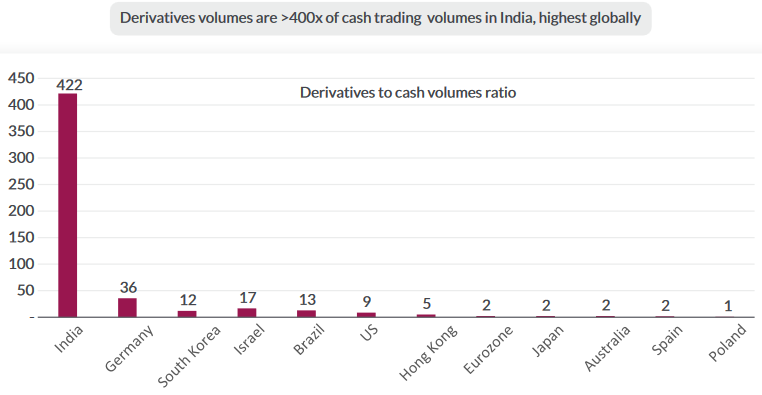
Source: WFE, ICICI Sec Data as on 31 July 2023
In most markets, derivatives volumes now account for 5-15x their cash market volumes. In India today however, derivative volumes are more than 400x higher than that of underlying cash market today, having grown from 3x in 2010. Total derivatives volumes have risen to over US$4.3tn per day roughly translating to 125% of the underlying companies’ market capitalization or over 200% of its free float being traded every day.
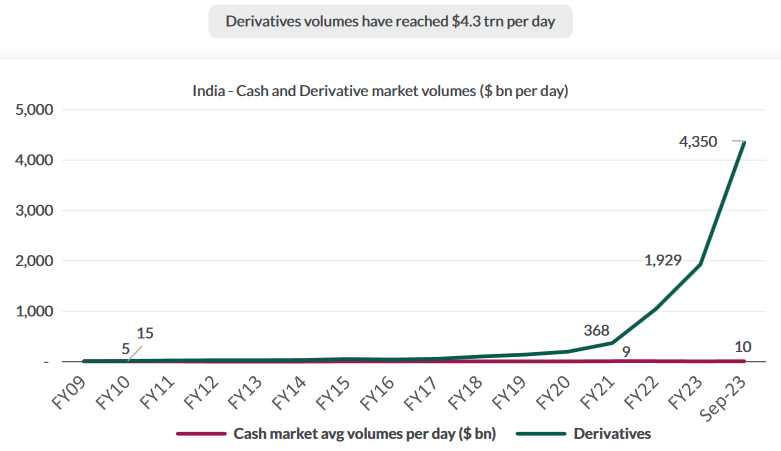
Source: NSE, BSE, Axis MF Research Data as on 30 September 2023
Gamification leads to influx of traders
Change in contract structure, leverage combined with the ease of onboarding and interface of the new generation trading apps has triggered gamification of this market with number of active derivatives traders jumping 8 times to 4 mn from less than 0.5m in 2019. In comparison, in the cash market, the number has grown 3 times - from ~3mn in 2019 to 11 mn.
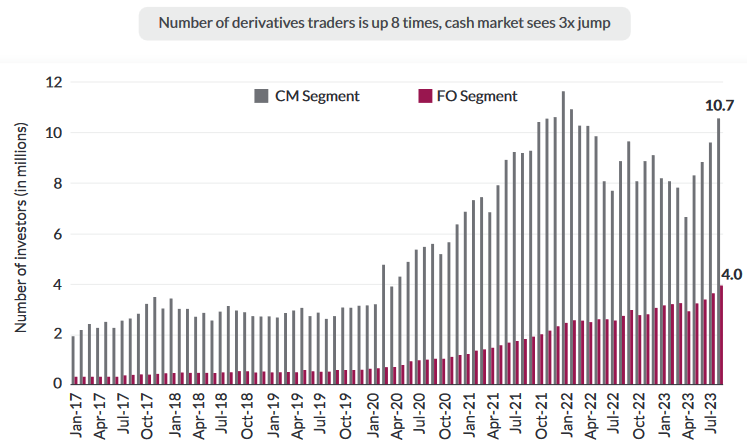
Source: NSE Data as on 31 August 2023
Of the over 5,000 companies listed in India, derivatives contracts are available for 193 stocks and indices. For these, there are ~46,000 individual contracts available at any point spanning products (futures, options), tenor and strike prices. Index options reign supreme accounting for 98% of total derivative volumes.
Sachet-ization of derivatives drawing younger clients from small towns
In the last four years, particularly during the covid era, leading online platforms saw their active client base grow multifold to 1.8 cr.
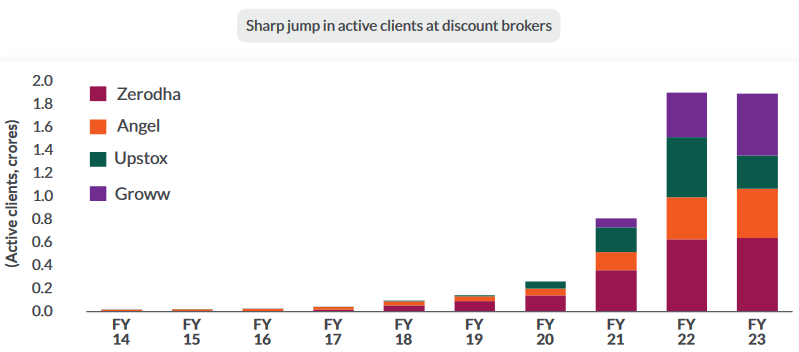
Source: NSE, Axis MF Research, Company data Data as on 31 March 2023
This growth has continued beyond the pandemic, with a notable portion coming from Tier-2 cities and beyond. For example, Angel One, saw its customer count increase by 4.6 million in FY23, with 90% of gross client additions originating from Tier 2 and 60% from Tier-3 cities. Geographically, most new investor additions are from North and West India.
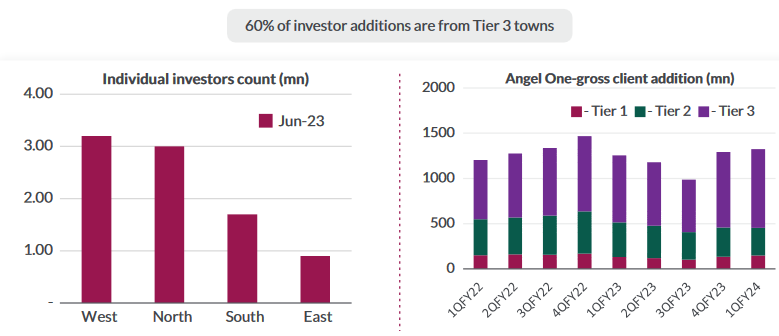
Source: NSE Pulse, Company Data Data as on 30 June 2023
The average age of an equity retail investor is 35 years, whereas those with digital discount brokers is 29 years, similar to 31 years for online gaming companies. Notably, half of the new customer additions are below 25.
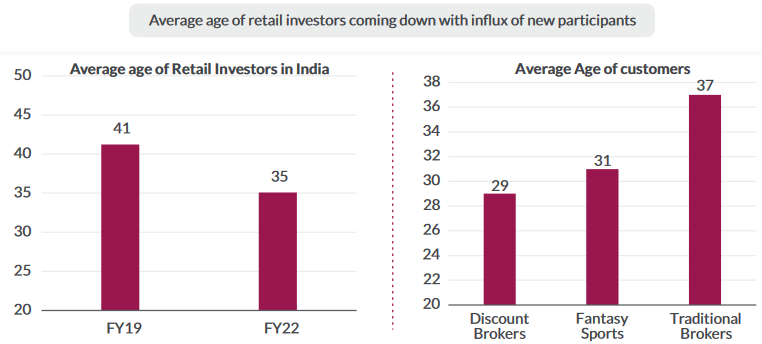
Source: Company data, News Reports Data as on 30 June 2023
Available leverage has gone up from 50x to 500x
The introduction of shorter duration in options has effectively “sachet-ized” trading, reducing the capital needed to take on similar risks. Weekly options are cheaper compared to monthly contracts, and buyers gain exposure to the full notional value by paying only 0.5-5% for the same. For example, Nifty's at-the- money (ATM) weekly contract is available at 40% of the cost of a monthly contract while offering the same notional value. This effectively increases leverage to 126x, from the 56x leverage offered by monthly contracts. In the case of zero-day-to-expiry options, leverage increases further to an astonishing 420x.

Source: NSE, Axis MF Research Data as on 31 July 2023
Zero day to expiry options already at 50% of volumes and are set to spike further.
Push to even shorter durations has ensured that the options market is shifting from hedging to speculation. Weekly options today accounts for 95% of volumes in the index. In the US, zero day to expiry options now constitutes 55% of S&P 500 volumes. The same is picking in India as well, with exchanges this year having re-aligned the expiries and these are available for every day of the week.
Most of the option volumes is speculative and this can also be gauged from the fact that open interest at the end of the day is only 1% of the daily traded volumes, i.e. only 1 out of 100 contracts are carried forward to the next day. Retailers option trading is also largely speculative given the average holding period of less than 30 mins.
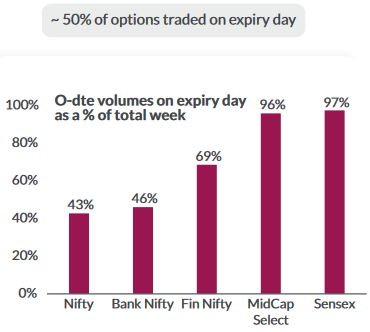
Source: NSE, BSE, Axis MF Research Data as on 31 July 2023
Fantasy sports offer better odds than options trading for retailers
In fantasy sports, the take rate of the pot is 15%. For every र 100 put in by the retail participants, they get र 85 back. The skew is opposite in derivatives, with only 15% of the pot coming back to retail. As per a recent SEBI study in FY22, retail traders on aggregate lost more than 80% of their bets (र45,000 cr was lost by 90% of participants while 10% of the participants earned र6,900 cr).
With higher leverage, risks rise as well
At a system level, derivatives have a useful economic function wherein risks can be transferred from those who do not want it to those who want it. Another useful function that the product provides is that of additional liquidity in the market, beyond what is available in the cash markets. The outsized derivatives market though can itself be a source of additional macro and market risk, we have seen this in global cases with CDS and derivatives contracts. Black swan events and resultant spike in volatility in particular can drive exaggerated moves in stock prices and result in market dislocation.
At an individual level as well, given the embedded leverage - the loss of capital can be significant even when buying options. This loss can be manifold of the initial capital when dealing with futures or selling/writing options. Given, that India’s Volatility Index today is at multi year low, option writers risk complacency and sharp market moves can lead to significant retail losses. A recent SEBI report highlights 9 out of 10 traders lose money, with ~र56,000 loss per person on average.
Disclaimer
Source of Data: Axis MF Research, NSE, BSE, WFE, Company reports.
This document represents the views of Axis Asset Management Co. Ltd. and must not be taken as the basis for an investment decision. Neither Axis Mutual Fund, Axis Mutual Fund Trustee Limited nor Axis Asset Management Company Limited, its Directors or associates shall be liable for any damages including lost revenue or lost profits that may arise from the use of the information contained herein. No representation or warranty is made as to the accuracy, completeness or fairness of the information and opinions contained herein. The material is prepared for general communication and should not be treated as research report. The data used in this material is obtained by Axis AMC from the sources which it considers reliable.
While utmost care has been exercised while preparing this document, Axis AMC does not warrant the completeness or accuracy of the information and disclaims all liabilities, losses and damages arising out of the use of this information. Investors are requested to consult their financial, tax and other advisors before taking any investment decision(s). The AMC reserves the right to make modifications and alterations to this statement as may be required from time to time
Axis Mutual Fund has been established as a Trust under the Indian Trusts Act, 1882, sponsored by Axis Bank Ltd. (liability restricted to र1 Lakh). Trustee: Axis Mutual Fund Trustee Ltd. Investment Manager: Axis Asset Management Co. Ltd. (the AMC) Risk Factors: Axis Bank Limited is not liable or responsible for any loss or shortfall resulting from the operation of the scheme.
(Mutual Fund investments are subject to market risks, read all scheme related documents carefully.)
MUTUAL FUND TOOLS & CALCULATORS
Recent News
-
Mr. Navneet Munot's 'Person of the Year 2025'
Dec 31, 2025
-
The Wealth Company Mutual Fund Receives SEBI Approval to Launch Specialized Investment Fund SIF
Nov 26, 2025
-
Axis Mutual Fund Launches Axis Multi Asset Active FoF Fund of Fund: A One Stop Solution for Dynamic Asset Allocation
Nov 21, 2025
-
The Wealth Company Mutual Fund makes record debut with four active NFOs, garners close to Rs 2000CR
Oct 29, 2025
-
Axis MF Launches Axis Income Plus Arbitrage Passive FOF
Oct 28, 2025







